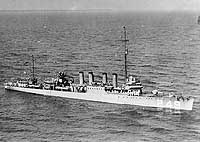
USS Hopkins, a 1190-ton Clemson class destroyer, was built at Camden, New Jersey. Following commissioning in March 1921, she engaged in combat training in the western Atlantic for more than a year. In October 1922 Hopkins steamed to the Mediterranean, where she operated in Turkish waters until May 1923. She served for the rest of the decade, and into the 1930s, in the Western Atlantic and Caribbean areas. Early in 1932 the destroyer shifted her base to San Diego, California, remaining in the Pacific until April 1939, when she went back to the East Coast. She engaged in Neutrality Patrol work during the last months of 1939 and the first part of 1940.
Hopkins returned to the Pacific in May 1940 and was soon sent on to Pearl Harbor, Hawaii. Later in the year she was converted to a high-speed minesweeper, receiving the new hull number DMS-13. Hopkins continued operations in the Hawaiian area until mid-1942, when she went to the South Pacific to take part in the invasion of Guadalcanal and Tulagi. After U.S. forces had established their initial, tenuous lodgement in the southern Solomon Islands, she remained in the area to provide escort, minesweeping and transport services during the rest of the campaign to secure Guadalcanal. In 1943 Hopkins joined in the Allied advance up the Solomons chain, participating in the occupation of the Russell Islands in February, the New Georgia invasion in July and the Bougainville landings in November.
With the South Pacific war zone largely under Allied control, Hopkins entered the Central Pacific to support the conquest of Saipan and Guam in mid-1944. Late in that year she went to the Philippines to take part in the Lingayen Gulf landings. While sweeping for mines off Luzon on 7 January 1945, Hopkins rescued nearly a hundred survivors of her sister ship Palmer (DMS-5), which had been sunk by Japanese bombs. Her next operation was the invasion of Iwo Jima in February, followed by the long fight to take Okinawa, lasting from late March until June 1945. Enduring regular air attacks during the latter campaign, Hopkins was near-missed by a suicide plane off Okinawa on 4 May but received no serious damage.
In late August 1945, following Japan's capitulation, Hopkins arrived off Tokyo Bay to begin minesweeping in support of initial occupation efforts. She left the Western Pacific in October and arrived at Norfolk, Virginia, late in the next month. Decommissioned four days before Christmas 1945, USS Hopkins was stricken from the Navy list a few weeks later and sold for scraping in November 1946.
USS Hopkins was named in honor of Commodore Esek Hopkins (1718-1802), the first Commander in Chief of the Continental Navy.
This page features, or provides links to, all the views we have related to Hopkins (DD-249, later DMS-13), 1920-1946.
For other pictures related to this ship, see:
| If you want higher resolution reproductions than the digital images presented here, see: "How to Obtain Photographic Reproductions." |
Click on the small photograph to prompt a larger view of the same image.
|
Photo #: NH 53570 USS Hopkins (DD-249) Photographed circa 1921. U.S. Naval Historical Center Photograph. Online Image: 109KB; 740 x 550 pixels |
 |
|
Photo #: NH 64562 USS Hopkins (DD-249) Underway in Guantanamo Bay, Cuba, 9 February 1930. Donation of Franklin Moran, 1967. U.S. Naval Historical Center Photograph. Online Image: 84KB; 740 x 610 pixels |
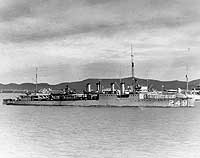 |
|
Photo #: NH 64561 USS Hopkins (DD-249) In San Diego harbor, California, during the early 1930s. USS Kane (DD-235) and USS Fox (DD-234) are moored in the right center background, with Naval Air Station North Island beyond them. Donation of Franklin Moran, 1967. U.S. Naval Historical Center Photograph. Online Image: 121KB; 740 x 605 pixels |
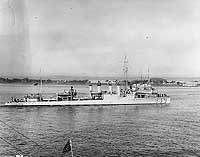 |
|
Photo #: NH 53571 USS Hopkins (DD-249) Painting by J.W. Burbank, 1931. U.S. Naval Historical Center Photograph. Online Image: 125KB; 740 x 595 pixels |
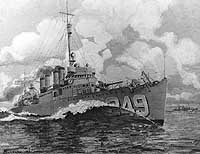 |
|
Photo #: 80-G-34683 (cropped) USS Hopkins (DMS-13) Steams past the transport area between Guadalcanal and Tulagi on 8 August 1942, the day after U.S. Marines landed at both places. This view is cropped from Photo # 80-G-34683. Official U.S. Navy Photograph, now in the collections of the National Archives. Online Image: 95KB; 740 x 610 pixels Reproductions of this image may also be available through the National Archives photographic reproduction system. |
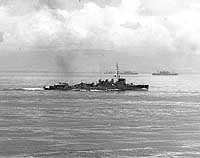 |
|
Photo #: 80-G-55757 USS Hopkins (DMS-13) Signalling to USS George Clymer (APA-27) in Empress Augusta Bay during the invasion of Bougainville, 1 November 1943. Official U.S. Navy Photograph, now in the collections of the National Archives. Online Image: 79KB; 740 x 605 pixels Reproductions of this image may also be available through the National Archives photographic reproduction system. |
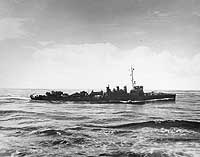 |
The following photographs show USS Hopkins (DD-249) with groups of other ships, or in the background of views of other subjects:
For other pictures related to this ship, see:
| If you want higher resolution reproductions than the digital images presented here, see: "How to Obtain Photographic Reproductions." |
Page made 10 December 2002